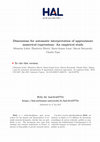Papers by Elisabetta Zibetti
HAL (Le Centre pour la Communication Scientifique Directe), Mar 29, 2011
International audienc
HAL (Le Centre pour la Communication Scientifique Directe), Mar 26, 2012
International audienc
John Wiley & Sons, Inc. eBooks, Sep 17, 2016
Les connaissances de base permettant de comprendre le fonctionnement cognitif d’un individu font ... more Les connaissances de base permettant de comprendre le fonctionnement cognitif d’un individu font appel a trois grands concepts : ce sont les notions de memoire, de representation et de traitement.Dans la deuxieme edition de cet ouvrage sont abordes successivement :· la memoire, dans toute sa pluralite et avec les caracteristiques propres a chacun des registres qui la composent ;· la representation, tout a fait essentielle en psychologie cognitive, puisqu’elle rend compte de nos contenus de pensee, nos connaissances et croyances ;· le traitement qui correspond aux operations et processus de transformation des representations en memoire.Avec ses exercices et QCM corriges, cet ouvrage est concu comme un outil de decouverte et d’approfondissement des notions fondamentales de la psychologie cognitive.
HAL (Le Centre pour la Communication Scientifique Directe), Jul 1, 2008
International audienc
HAL (Le Centre pour la Communication Scientifique Directe), Mar 28, 2009
International audienc

IEEE Conference Proceedings, 2019
The control of multiple robots in the context of tele-exploration tasks is often attentionally ta... more The control of multiple robots in the context of tele-exploration tasks is often attentionally taxing, resulting in a loss of situational awareness for operators. Unmanned aerial vehicle swarms require significantly more multitasking than controlling a plane, thus making it necessary to devise intuitive feedback sources and control methods for these robots. The purpose of this article is to examine a swarm's nonverbal behaviour as a possible way to increase situational awareness and reduce the operators cognitive load by soliciting intuitions about the swarm's behaviour. To progress on the definition of a database of nonverbal expressions for robot swarms, we first define categories of communicative intents based on spontaneous descriptions of common swarm behaviours. The obtained typology confirms that the first two levels (as defined by Endsley: elements of environment and comprehension of the situation) can be shared through swarms motion-based communication. We then investigate group motion parameters potentially connected to these communicative intents. Results are that synchronized movement and tendency to form figures help convey meaningful information to the operator. We then discuss how this can be applied to realistic scenarios for the intuitive command of remote robotic teams.
HAL (Le Centre pour la Communication Scientifique Directe), 2011
International audienc
Journal of human-robot interaction, Jan 20, 2017
A new race of artifacts comes equipped with behavioral properties. Those properties transmute the... more A new race of artifacts comes equipped with behavioral properties. Those properties transmute the very nature of the object, granting it a life of its own and a special status that stems from the psychological attributions humans naturally produce when confronted by autonomous movements. This article examines what makes behavioral objects special in terms of the psychological properties they evoke in an observer. We look into the notion of behavior and evaluate to what extent the concept of anthropomorphism is a valid construct when considering the behavior of artificial objects. Based on recent research in cognitive psychology, we propose a framework to conceptualize the way people infer psychological attributes from movement, and the way it applies to behavioral objects.

HAL (Le Centre pour la Communication Scientifique Directe), Jul 9, 2017
Imprecisions related to numerical expressions are pervasive in human communication. The way they ... more Imprecisions related to numerical expressions are pervasive in human communication. The way they are propagated in calculations is still an issue. Fuzzy logic is an attempt to account for human imprecise reasoning. In this paper, a comparison between human imprecise calculation and fuzzy arithmetic is experimentally performed. An empirical study has been conducted to collect real intervals resulting from imprecise products and additions from participants. Fuzzy intervals are elicited from these data and fuzzy arithmetic is applied to the collected imprecise operands. Comparisons of the fuzzy intervals show that the fuzzy product and addition do not fit well they way human beings perform these operations on imprecise operands. Moreover, they show that the participants, rather than taking into account the imprecisions in the calculation, realise exact calculation and then approximate the exact result.
HAL (Le Centre pour la Communication Scientifique Directe), Nov 3, 2016
Les Expressions Numériques Approximatives, ou ENA, sont des expressions linguistiques de la forme... more Les Expressions Numériques Approximatives, ou ENA, sont des expressions linguistiques de la forme "environ x", où x est un nombre. Cet article propose un modèle d'interprétation des ENA basé sur un compromis entre saillance cognitive des nombres et plage de valeurs dénotées. Contrairement aux modèles de la littérature qui représentent les ENA par des intervalles, nous proposons de les représenter par des nombres flous et d'en caractériser le support, le noyau et la 0,5-coupe. Une étude expérimentale, basée sur des données réelles collectées met en évidence les performances du modèle.
This paper proposes an experimental comparison between human imprecise calculation and fuzzy arit... more This paper proposes an experimental comparison between human imprecise calculation and fuzzy arithmetic: an empirical study has been conducted to collect real intervals resulting from products and additions with imprecise operands from participants. Fuzzy intervals are elicited from these data and fuzzy arithmetic is applied to the collected imprecise operands. Comparisons show that the fuzzy product and addition differ from the way human beings perform these operations. Moreover, they show that the participants, rather than taking into account the imprecisions in the calculations, realise exact calculation and in the end approximate the exact result.
Autonomous Robots, Jan 30, 2023
HAL (Le Centre pour la Communication Scientifique Directe), Sep 7, 2011
International audienc

The robotics community is considering the use of large groups of robots, also known as artificial... more The robotics community is considering the use of large groups of robots, also known as artificial swarms for applications in unknown and dynamic environments. In this context, swarms of robot will need to interact with users to accomplish their mission. Unfortunately, little is known about the users' perception of group behavior and dynamics, as well as what is the best interaction modality for swarms. In this paper, we focus on the movement of the swarm as a group to convey information to a user: we believe that the interpretation of artificial states based solely on the motion can lead to promising natural interaction modalities. We define the expressivity of a movement as a metric to understand how natural, readable, or easily understandable such movement may appear. We then correlate expressivity with the control parameters for the distributed behaviour of the swarm. A user study confirms the relationship between inter-robot distance, temporal and spatial synchronicity, and the perceived expressivity of the robotic system.

mp m xp h "about 100 meters" p g g. Mobile robotics, Geographic Information Systems, intelligent ... more mp m xp h "about 100 meters" p g g. Mobile robotics, Geographic Information Systems, intelligent personal assistants as well as database querying applications are required to automatically and accurately interpret such expressions, called Approximate Numerical Expressions (ANE). The main challenge is to determine their numerical boundaries that sound plausible to users. The aim of this paper is to provide guidelines to interpret ANEs that are independent from the domain and the formal representations. We identified three arithmetical properties and examined their involvement in ANE interpretation as intervals of denoted values. The implicit assumption of symmetry of the intervals was also tested. To do so, 146 participants were asked to provide the intervals corresponding to 24 ANEs in a semantically neutral context. Results suggest that the properties of ANEs we identified are key factors in their interpretation while symmetry is not always maintained. This study contributes towards an understanding of how users process ANEs and its results can be used to improve intelligent interfaces that ' f between him/her and the system.
In contemporary art, a new type of artworks use motion as a material from which to create the ill... more In contemporary art, a new type of artworks use motion as a material from which to create the illusion of life. These autonomous robotic artworks have a behavioral specificity; they tend to be perceived as living, and by some account intentional entities. To account for this behavioral specifity and how it affects the audience experience, we propose a data-driven approach to reveal specific visit patterns. Through a cluster analysis performed on visitors' path inside an installation involving autonomous objects, we highlight four different attitudes characterized by patterns of approach or withdrawal, passive observation and exploration.











Uploads
Papers by Elisabetta Zibetti